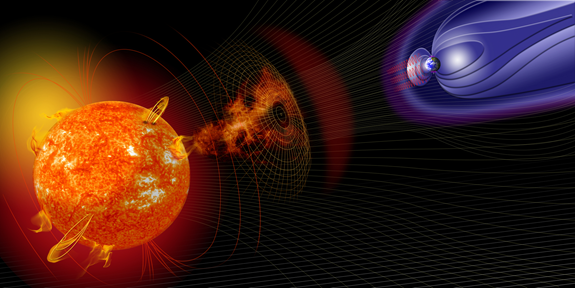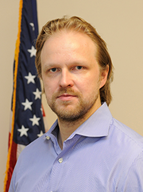Space Weather, Earthly Effects
Sunspots, Ion Storms, Magnetic Shields, Plasma Wakefields and More
Antti Pulkkinen
Astrophysicist
NASA Goddard Space Flight Center/Adjunct Professor of Astrophysics
Institute for Astrophysics and Computational Sciences, Catholic University
About the Lecture

From the physics standpoint, space weather is the ultimate challenge for our understanding of the heliophysics system – the chain of interacting complex domains ranging from the Sun to the upper mantle of the Earth. Predicting the dynamic evolution of the system is the test for our capacity to capture the key physical processes operating in these domains. In addition to its fundamental scientific interest, understanding physics is also of increasing importance on earth. As our technology advances we are becoming more and more vulnerable to “space weather.” We have witnessed this increasing vulnerability to space weather since the 19th century when it was discovered that the telegraph system was being impacted by geomagnetic storms caused by solar activity. Since then a wide variety of technologies, including radio communications, power grids and global navigation satellite systems also have been found to be vulnerable to heliophysics driven space weather. The potential for widespread problems in operating modern technological systems during major space weather storms has prompted increasing international policy, science, industry, and public interest in the problem, and finding ways to protect vital systems from the “fury of the sun.” In the U.S., the latest high-level attention is centered around regulatory action initiated by the Federal Energy Regulatory Commission and GIC-related elements of the National Space Weather Strategy and National Space Weather Action Plan. Understanding heliophysics will lead to the development of novel strategies for dealing with space weather based on advanced warnings about potentially hazardous space weather conditions. In this lecture I will discuss the key moving parts of the heliophysics system and highlight some of the key challenges in extracting new information about the system. I will then connect the heliophysics to space weather affects on society and discuss how modern technology-dependent society is exposed to the fury of the Sun. I will also discuss some of the latest advances in addressing the space weather hazards and highlight some of the most important U.S. federal government actions on the topic.
About the Speaker

Antti Pulkkinen is currently an Astrophysicist and Acting Deputy Director for the Heliophysics Science Division at NASA Goddard Space Flight Center. He also is an Adjunct Professor at the Catholic University of America. Previously, he served as Associate Director of Institute for Astrophysics and Computational Sciences at Catholic. Antti has long been involved in leading space weather-related projects, often with other scientists in close collaboration with end-users. His work has involved general empirical studies, first-principles modeling of space weather, and investigations of the effects on manmade systems in space and on the ground. He also has been actively involved in promoting research and education in helophysics, launching a new Space Sciences and Space Weather program at Catholic University to educate the next generation of space weather scientists. Among other awards, Antti is the recipient of a NASA Exceptional Achievement Award, and the International Kristian Birkeland Medal for his efforts to address space weather effects on power grids. Antti earned a PhD in theoretical physics at the University of Helsinki, Finland.
Minutes
President Larry Millstein called the 2381st meeting of the Society to order at 8:04 p.m. President Millstein announced the order of business, announced the evening’s lecture would be livestreamed on the internet, and welcomed new members. The minutes of the previous meeting were read and approved. President Millstein then introduced the speaker for the evening, Antti Pulkkinen, Acting Deputy Director of the Heliophysics Science Division, NASA Goddard Space Flight Center. His lecture was titled “Space Weather, Earthly Effects.”
Dr. Pulkinnen began by explaining that “space weather” refers to the conditions on the Sun and in interplanetary space which can affect human infrastructure both in space and on Earth.
Space weather in our solar system is driven by the sun, and the science of space weather is plasma physics. Summarizing the fundamentals, Pulkinnen explained that because plasma is electrically charged, electromagnetism plays a fundamental role in dictating how plasma evolves. For example, the aurora borealis is plasma organized along the Earth’s electromagnetic field. Moreover, the temporal range of space weather scales is challenging, ranging from 10-9 seconds to 108 seconds, and the length of a solar cycle is approximately 11 years. Similarly, the relevant spatial scales vary from 1 meter to 108 meters, the size of the solar system. These characteristics make forecasting space weather a serious challenge.
Space weather forecasting focuses on the 6600 kelvin convection zone of the sun, which sits just below the cooler photosphere, where plasma is most active. The motion of plasma within the sun is organized by the sun’s magnetosphere. Clumping of strong magnetic fields result in “sun spots,” dark areas in the photosphere that are 1000-2000 kelvin cooler than the surrounding plasma. Reviewing 400 years of sun spot observations reveals that the number of sun spots peaks every 11 years.
Large numbers of sun spots indicate additional complexity in the sun’s magnetic field, which translate to an increased probability of major eruptions at the sun’s surface. Those major eruptions include solar flares and coronal mass ejections.
Solar flares are one kind of solar eruption. Lasting 1 to 60 minutes, a solar flare can release upwards of 1025 joules, mostly in the form of electromagnetic radiation, which exceeds the annual world energy consumption of around 1020 joules.
Coronal mass ejections release similar quantities of energy. But, the majority of the energy released in a coronal mass ejection is released in the bulk motion of plasma into the surrounding heliosphere, at rates in excess of 3000 kilometers per second.
While Earth’s magnetic field largely shields us from charged particles coming from the sun, some charged particles do make it through. When mass energy makes it through, it creates electric currents that flow through the Earth’s magnetosphere generating magnetic field perturbations on the surface of the Earth. These fluctuations are called geomagnetic storms.
While scientists have been interested in space weather since the dawn of the space age, it is its effects on modern infrastructure that have drawn political attention. Hundreds of years ago, space weather impacts were largely limited to impressive visual displays such as borealis near the North and South poles. But now, space weather phenomena can influence global navigation systems, high frequency signals, microelectronics in spacecraft, and disruption of ground-based infrastructure such as high-voltage power systems.
As a public policy concern, Pulkinnen said space weather began to receive high-level U.S. government interest in 2008, following a report on potential major impacts of space weather on the high-voltage electrical grid. Space weather policy is now of concern to the White House and Congress, resulting in what Pulkinnen describes as the “golden age” of space weather attention from the federal government.
Now, in addition to worrying about spikes in radiation levels for astronauts orbiting in space, we must address the vulnerability of ground-based systems to major space weather events. For example, coronal mass ejections may cause geomagnetic storms that create large variations of electric currents to the order of millions of amps, which are hazardous to long conductor systems – such as railway systems, oil pipelines, and high-voltage power transmission systems. Fluctuations in voltage in high-voltage power grids may damage transformers and collapse systems. Such a collapse occurred in Quebec in 1989.
Pulkinnen concluded, we are still learning about the causes and effects of space weather. We are just beginning to develop the mitigation tools that will be necessary to protect us from major space weather events as protection of systems that are susceptible to such events are increasingly crucial to the functions of society.
President Millstein then invited questions from the audience.
One questioner asked about whether private utilities are taking the necessary steps to secure power systems from space weather events. Dr. Pulkinnen said most U.S. utilities pay attention to NOAA space weather predictions and have taken effective mitigation measures per federal regulation.
A livestream viewer asked, given the recent increase in satellite communication infrastructure development during the current calm in the solar cycle, whether we are headed for disaster as conditions deteriorate. Dr. Pulkkinen said while NASA has rigid design criteria for its craft to withstand major space weather events, he believes commercial operators may not be developing their systems to the same specifications. Educating operators is key, Pulkinnen said, to encourage them to implement the necessary mitigation measures.
After the question and answer period, President Millstein thanked the speaker, made the usual housekeeping announcements, and invited guests to join the Society. At 9:40 p.m., President Millstein adjourned the 2381st meeting of the Society to the social hour.
Attendance: 87
The weather: Clear
The temperature: 18°C
Respectfully submitted,
James Heelan
Recording Secretary